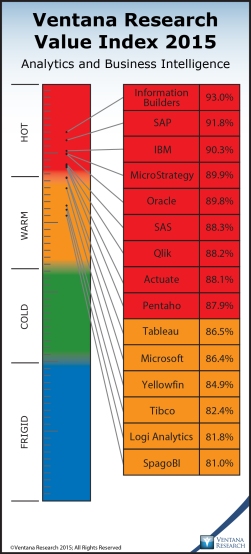Ventana Research recently completed the most comprehensive evaluation of analytics and business intelligence products and vendors available anywhere. As I discussed recently, such research is necessary and timely as analytics and business intelligence is now a fast-changing market.
Ventana Research recently completed the most comprehensive evaluation of analytics and business intelligence products and vendors available anywhere. As I discussed recently, such research is necessary and timely as analytics and business intelligence is now a fast-changing market. Our Value Index for Analytics and Business Intelligence in 2015 scrutinizes 15 top vendors and their product offerings in seven key
The evaluations drew on our research and analysis of vendors’ and products along with their responses to our detailed RFI or questionnaire, our own hands-on experience and the buyer-related findings from our benchmark research on next-generation business intelligence, information optimization and big data analytics. The benchmark research examines analytics and business intelligence from various perspectives to determine organizations’ current and planned use of these technologies and the capabilities they require for successful deployments.
We find that the processes that comprise business intelligence today have expanded beyond standard query, reporting, analysis and publishing capabilities. They now include sourcing and integration of data and at later stages the use of analytics for planning and forecasting and of capabilities utilizing analytics and metrics for collaborative interaction and performance management. Our research on big data analytics finds that new technologies collectively known as big data
In addition, the 2015 Value Index includes assessments of their self-service tools and cloud deployment options. New self-service approaches can enable business users to reduce their reliance on IT to access and use data and analysis. However, our information optimization research shows that this change is slow to proliferate. In four out of five organizations, IT currently is involved in making information available to end users
Similarly, our research, as well as the lack of maturity of the cloud-based products evaluated, shows that organizations are still in the early stages of cloud adoption for analytics and business intelligence; deployments are mostly departmental in scope. We are exploring these issues further in our benchmark research into data and analytics in the cloud, which will be released in the second quarter of 2015.
The products offered by the five top-rated companies in the Value Index provide exceptional functionality and a superior user experience. However, Information Builders stands out, providing an exceptional user experience and a completely integrated portfolio of data management, predictive analytics, visual discovery and operational intelligence capabilities in a single platform. SAP, in second place, is not far behind, having made significant progress by integrating its Lumira platform into its BusinessObjects Suite; it added predictive analytics capabilities, which led to higher Usability and Capability scores. IBM, MicroStrategy and Oracle, the next three, each provide a robust integrated platform of capabilities. The key differentiator between them and the top two top is that they do not have superior scores in all of the seven categories.
In evaluating products for this Value Index we found some noteworthy innovations in business intelligence. One is Qlik Sense, which has a modern architecture that is cloud-ready and supports responsive design on mobile devices. Another is SAS Visual Analytics, which combines predictive analytics with visual discovery in ways that are a step ahead of others currently in the market. Pentaho’s Automated Data Refinery concept adds its unique Pentaho Data Integration platform to business intelligence for a flexible, well-managed user experience. IBM Watson Analytics uses advanced analytics and
The Value Index analysis uncovered notable differences in how well products satisfy the business intelligence needs of employees working in a range of IT and business roles. Our analysis also found substantial variation in how products provide development, security and collaboration capabilities and role-based support for users. Thus, we caution that similar vendor scores should not be taken to imply that the packages evaluated are functionally identical or equally well suited for use by every organization or for a specific process.
To learn more about this research and to download a free executive summary, please visit.